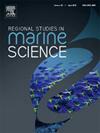日本有明海蚜蝇藻垂直迁移导致底层水缺氧加剧
IF 2.1
4区 环境科学与生态学
Q3 ECOLOGY
引用次数: 0
摘要
一般来说,沿岸水域缺氧水团的形成是由于分层现象的加强限制了氧气的垂直输 送,以及浮游植物大量繁殖所产生的有机物的分解导致耗氧量增加。然而,浮游植物藻华与缺氧之间的直接关系却鲜有报道。在本研究中,我们通过实地调查和测量水体需氧量的实验,阐明了日本有明海缺氧水体(< 3 mg L-1)的形成与虹彩藻类 Chattonella sp.观察了缺氧水团在春潮-低潮周期中的发展和恢复过程。从春潮到小潮,来自近海的高盐度、高密度海水侵入海湾内部的底层,加强了分层,形成了缺氧水团。在此期间,细菌需氧量在底层白天占主导地位。夜间,由于积聚在底层的 Chattonella 的呼吸作用,耗氧量增加,达到白天的五倍。在接下来的春潮中,分层作用减弱,缺氧水体消失。然而,水体的需氧量最高,这表明造成水华的 Chattonella 腐烂产生了影响。这些结果表明,由于 Chattonella 的昼夜垂直迁移,夜间耗氧量增加,这在很大程度上影响了缺氧水团的形成。本文章由计算机程序翻译,如有差异,请以英文原文为准。
Bottom water hypoxia enhanced by vertical migration of the raphidophyte Chattonella sp. in the Ariake Sea, Japan
In general, the formation of hypoxic water masses in coastal waters is caused by the restriction of vertical oxygen transport due to enhanced stratification, and the increase in oxygen consumption due to the decomposition of organic matter supplied from phytoplankton blooms. However, the direct relationship between phytoplankton blooms and hypoxia has been rarely reported. In this study, we clarified the relationship between the development of a hypoxic water mass (< 3 mg L−1) and a bloom of the raphidophyte Chattonella sp. in the Ariake Sea, Japan through field surveys and experiments to measure the water oxygen demand. The process of development of and recovery from the hypoxic water mass in a spring-neap tidal cycle was observed. From the spring to the neap tide, high-salinity, high-density water from offshore intruded into the bottom layer of the inner part of the bay, strengthening the stratification and developing a hypoxic water mass. In this period, the bacterial oxygen demand was dominant during the day in the bottom layer. At night, oxygen consumption increased due to the respiration of Chattonella that had accumulated in the bottom layer, reaching five times the amount during the day. In the following spring tides, the stratification weakened and the hypoxic water mass disappeared. However, water oxygen demand was the highest, suggesting the influence of the decay of Chattonella that caused the bloom. These results indicate that the increase in oxygen consumption at night due to the diurnal vertical migration of Chattonella greatly influenced the development of the hypoxic water mass.
求助全文
通过发布文献求助,成功后即可免费获取论文全文。
去求助
来源期刊

Regional Studies in Marine Science
Agricultural and Biological Sciences-Ecology, Evolution, Behavior and Systematics
CiteScore
3.90
自引率
4.80%
发文量
336
审稿时长
69 days
期刊介绍:
REGIONAL STUDIES IN MARINE SCIENCE will publish scientifically sound papers on regional aspects of maritime and marine resources in estuaries, coastal zones, continental shelf, the seas and oceans.
 求助内容:
求助内容: 应助结果提醒方式:
应助结果提醒方式:


